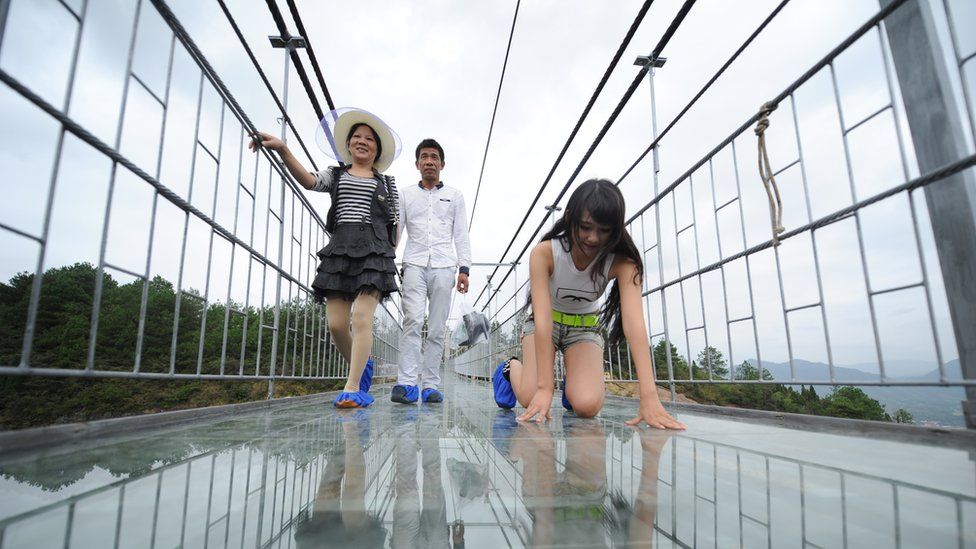China tourism: Crossing the new glass bridges
- Published

For some in China the sky does not need to be the limit, especially when you can build a glass-bottomed suspension bridge across it.
Tourism sites in the central Henan and Hunan provinces have been constructing vertigo-inducing skywalks in a bid to attract visitors.
And it seems to have worked, attracting thrill-seeking tourists and locals, all wanting a chance to experience a bird's eye view of the Chinese countryside.
One of them is student Li Shu Zhen, 19, from Hangzhou city.
She shared with the BBC her experience of climbing the Brave Man's Bridge in Pingjiang county, Hunan province.
"You look down and feel a sense of fear, but you quickly recover from that and enjoy the scenery," she said.
"It was beautiful, almost as if one was walking on air."
The fully transparent bridge, which measures 300m long (984ft) and 180m high, first opened to the public in September.
It is one of the more popular bridges, with events - like mass yoga displays - often being staged on it.
Local officials say that glass panels were designed to withstand high winds and earthquakes, as well as the "weight of 800 visitors".
Glass bridge fever has also spread to neighbouring Taiwan, where a 179m-high bridge opened in Nantou county.
'Even if the glass breaks'
Construction on the latest bridge, touted as the world's longest glass-bottomed walkway, is also nearing completion.
Standing at 300m high and stretching 375m, the bridge will hang above the Zhangjiajie grand canyon, also in Hunan province.
Gearing up for the bridge's 2016 opening, officials have even enlisted the public's help in naming it.
One of its engineers, Yang Guohong, from state-owned China Railway Major Bridge Reconnaissance and Design Institute, said contractors had taken extra safety precautions.
"No matter how the tourists jump on the bridge, it will still be fine," he told the People's Daily newspaper.
"The steel structures beneath it are incredibly dense, so even if the glass breaks, visitors won't fall through."
But architects who spoke to the BBC said that such glass bridges were often "primarily a novelty, built as visitor attractions rather than commuter bridges".
Architect Keith Brownlie, who was involved in a glass bridge for The London Science Museum, said that the appeal was "thrill".
"It is the relationship between emotionally driven fear and the logical understanding of safety," he said. "These structures tread the boundary between those two contrasting senses and people like to challenge their rational mind in relation to their irrational fear."
Others felt that the bridges symbolised extravagance, especially in China.
"In architecture, glass has always been associated with luxury and often as a display of wealth," said bridge designer Ezra Groskin.
"Glass floor panels, used in the creation of invisible architecture, are not a new phenomenon. However its use is often restricted due to cost and practicality."
Shattered nerves
But how safe are China's glass bridges?
An incident in October sent terrified visitors fleeing in fear after part of a glass skywalk in Henan province's Yuntai Mountain Geological Park cracked, despite only being open for two weeks.
Park officials closed the walkway immediately, later saying there was "no reason for worry" and that the cracks had "no impact on safety".
But experts questioned the use of glass in an exposed mountain environment.
"While a glass structure designed by a competent engineer and manufactured by a specialist contractor has no greater risk in terms of structural integrity than any other building material, glass can be prone to localised shocks," noted architect Adam Holicska.
"The use of it in a mountain environment where there is a potential risk of rock impact can make it a questionable choice."
Architect Keith Brownlie added that the cleaning of glass panels and lack of slip resistance should also be considered in such an environment.
"One issue with glass decks is the problem of grip," he said. "Glass is slippery and so anti-slip properties must be provided,"
"Please, no more such bridges," commented a user on China's popular micro-blogging site Weibo. "Judging from this incident, it is only a matter of time before more serious accidents and deaths occur."
But glass bridge enthusiasts remain undeterred.
"I still would not hesitate to visit other glass bridges soon," Ms Li admitted.
Other netizens on the site also expressed similar opinions.
"I am confident that officials will step up additional measures after that happened," said one Weibo user.
"Thankfully deaths were avoided but one bad incident should not put one off from conquering such a spectacular bridge."
Another compared it to other bridges of the world: "If Sydney's Harbour Bridge experienced a crack, I doubt government officials would close it down. So we should not let such an episode affect our opinions about our unique Chinese structures."
- Published25 August 2023